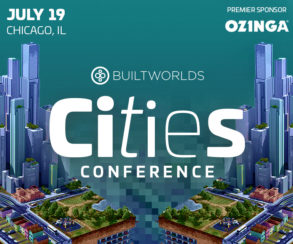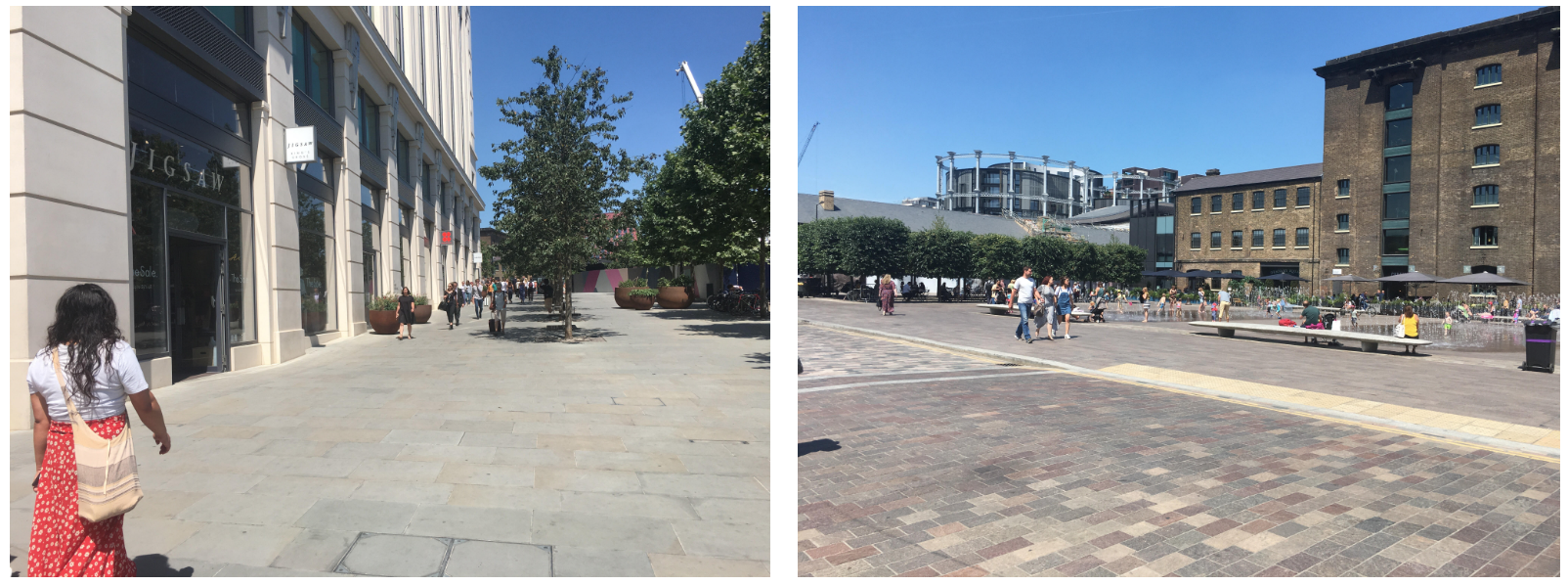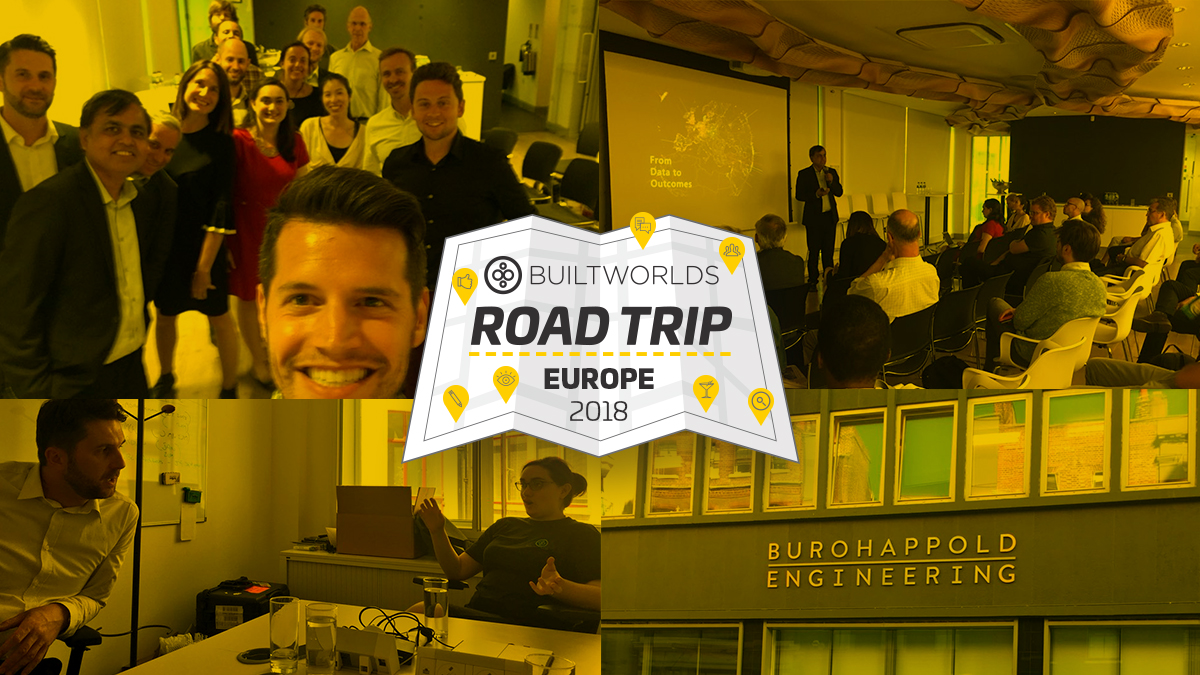For those who don’t know, BuiltWorlds is in Europe this week meeting with some of the major players in the EU’s built world tech ecosystem. Each day, Isabel Singer and Nick Durham will be producing written recaps of the trip, citing notable stops and major takeaways from our meetings. For live updates, follow us on Twitter.
Getting to London
9:25 am – Nick

The truth is, I’ve been here for a few days and have had time to settle in. So this morning hasn’t been too stressful.
But then I spend a few minutes outlining my day and realize that it’s going to be busier than I thought. The 1:00 p.m. tour at King’s Cross with Argent (the developer of the new King’s Cross redevelopment), lunch with a member company after, and then immediately onto our London Smart Cities meetup from 5:30 to 8:00 p.m. Logistically, we’ve also got to check into our Airbnb and drop our stuff off at some point.
After answering a few emails, I head to the Tube to start Day 1 of the Vlog (yes, yours truly will be Vlogging this trip). I roam into the Westminster area and get iconic shots of the Thames and the Eye and announce to the Twittersphere that Day 1 of #BWEuroTrip has kicked off.
11:13 a.m. – Isabel
The eagle has landed in London. I’m excited to finally be on the #BWEuroTrip!
King’s Cross Tour
1:15 pm – Isabel
I show up at the Argent office in my travel gear: a BuiltWorlds t-shirt, jeans, and Converse. I looked around at several men in suits, thinking that I clearly should have brought my best British formal wear.

For those which don’t know much about it, King’s Cross is a renovated train station and commercial district in the heart of London. In 1865, the train station was a “depot of goods in London. Trains would come in from the north and deliver into the upper levels. As it grew, it became a very decayed and nasty area.”
David Partridge, Joint Chief Executive of Argent, begins the tour by showing the group a model of the entire district of King’s Cross, featuring newly renovated commercial office space, retail, residential, and a university campus. The colored buildings have either been finished or are under construction. The non-colored have only been designed. He walks through most of the buildings and gives a unique story behind each one, such as Google’s new U.K. headquarters that has a park on its roof.
“Retail is becoming an experience as opposed to just a place where you pile high and stack it deep,”
The King’s Cross development is a testament to infrastructural sustainability. The most obvious way the development embodies sustainability is in its commitment to the environment. 100% of the heat and hot water for the development is generated in a central facility and pumped out to the buildings, which lowers the development’s carbon emissions. Argent also made a commitment to have 50% green roofs, where res
idents and animals alike can get some fresh air.

It also embodies sustainability because it is flexible. As David said, “we’d joke in 2006 that the people for whom we were building this didn’t even exist yet!” The devotion to flexibility led Argent to build the development around public spaces. David tells us that cities are defined by streets and squares. The
buildings might change from commercial offices to retail to residential properties and back again, but the master plan will remain the same. These public spaces also allow the development to be socially sustainable, creating areas for community building.
One of David’s most relatable points was his insistence that sustainable infrastructure is financially viable infrastructure. Argent initially funded its public infrastructure through site sales and continues to fund it through renting retail spaces. The social and financial visions for King’s Cross come together beautifully in the Coal Drop Yard, a nineteenth-century shed for storing coal that Argent has transformed into a retail experience.
“Retail is becoming an experience as opposed to just a place where you pile high and stack it deep,” David

informed us. “We have to make sure the Coal Drop Yard is a destination. Every single occupier here is doing a one-off. They’re only doing things here
that they don’t do on the high street.”
Retail spaces, when designed for the end user, can be public gathering points for so much, including cultural expression and creativity. That’s a pretty great insight to tie together our Cities Conference and the Buildings 2.0 Retail Day.
3:30 p.m. – Nick
David has to run to a meeting. I decide to continue the visit by doing a walking tour around King’s Cross. I can’t help but notice how nice everything is. Nike and other top fashion storefronts are lining the long cobblestone streets. Dozens of children and mothers are playing in a water fountain close by. There’s a modern amphitheater seating section nearby where people are enjoying lunch and a beautiful summer day. I mean, seriously, this place is nice. A far cry from the “desperate, prostitution and drug-ridden, no go area” as David described it 25 years ago.

London Cities Meet-Up
5:04 p.m. – Nick
We head out to the BuroHappold offices, where we’re hosting our Smart Cities Meet-Up this evening. Arriving is a significant moment because this conversation started two years ago at our 2017 Summit, where BuroHappold introduced a city planning app they were developing. Now, we’re here meeting with them in London to learn more about their city work. Pretty cool.
One of our favorite moments last night was arriving @burohappold’s London office. The conversation started at our 2017 Summit, where Buro introduced a city planning app they were developing. Now, we’re in London to learn more about their #SmartCity initiatives. pic.twitter.com/NaCwNGzDWf
— BuiltWorlds (@builtworlds) June 26, 2018
5:45 p.m. – Isabel
Nick and I prep the speakers. They are naturals and assure us they are ready to go.
The lineup looks like this:
Lukasz Adamik, Microdesk
Shrikant Sharma, BuroHappold
Daniel Ringelstein, SOM
Elaine Trimble, Siemens
Laurence Kemball-Cook, Pavegen
I open the speaking portion of the meetup and pass the baton to Lukasz Adamik from Microdesk, the moderator for tonight’s action.
Much of the conversation on big data in smart cities and infrastructure boiled down to Shrikant Sharma’s observation that “it’s not about how to get more data, but what to do with the data,” both logistically and ethically.
According to Shrikant, data allows us to “learn the hell out of what our existing environments are doing” and “feed that into very early decision making.” However, as Daniel Ringelstein of SOM warns, “once you have the data, you have to put it into a model. Creating the model takes time.”
Shrikant Sharma from @burohappold using the overcrowded NYC highline as a case study of how to use data to fix a traffic problem. pic.twitter.com/mW9r2vZjBU
— BuiltWorlds (@builtworlds) June 25, 2018
Though models can be complex and time-consuming, both BuroHappold and Siemens have managed to feed data into models that provide simple actionable insights in user-friendly ways.
Take the New York City’s High Line. Shrikant describes it as “a victim of its own success. You can’t walk. How do you start to address a problem like this? You start mining data.” BuroHappold created a simple real-time dashboard that demonstrates, hour-by-hour, which parts of the High Line are too congested. The model can also predict new traffic flows based on proposed real estate developments and infrastructure changes to the High Line itself. This way, the model allows urban planners to accurately predict the impact of their infrastructure adjustments before building them.
“Most of the things we’re hearing about in #SmartCities is related to fancy lights or energy savings that don’t affect me. But what I’m asking is: I’m giving up my data, how is it going to improve the quality of my life?” – @Lainey_Trimble from @SiemensCities pic.twitter.com/Zfbt1n6Tpe
— BuiltWorlds (@builtworlds) June 25, 2018
Elaine Trimble from Siemens talks about delivering similarly actionable insights on air quality data. By law, European cities are required to have air quality sensors. Elaine says, “we’re uploading the cities sensor data and creating a dashboard for the city, which can forecast air quality with 90% accuracy.” City officials can use this data to create localized, day-specific regulations for cars and other polluting agents.
Another key talking point was around the ethical concerns of data. Elaine emphasizes that cities have an ethical obligation to ensure that the data collection benefits the citizens. “If I’m giving up my data, I need to know how it’s going to be improving my quality of life,” she insisted. According to Laurence Kemball-Cook of Pavegen, the key to ethical data collection is to get individuals to give up their data willingly, by offering them rewards and incentives in exchange for their data.
Lukasz summarised the Meet-Up best, observing that “we know technology is the answer. We just have to ask the right questions.”
7:45 p.m. – Nick
We welcome the audience to the Town Hall part of the evening and invite them to ask questions to our panelists. One of the major questions is around data use related to social media (a topic from earlier) and different key predictive elements. The discussion between Laurence and Shrikant get a little heated. In a good way.
In true millennial form, I ask the remaining audience to take a selfie with me. I close by introducing the possibility of bringing a BuiltWorlds Conference to Europe in 2019…and we all talk excitedly about it.
Isabel and I pack up and search for the nearest Fish and Chips joint to whet our growing appetite before starting to write this piece.
London, tonight was wonderful. We had quite the engaging discussion around the future of our cities. In true BW fashion, all stakeholders were represented. Same time, next year only a bigger conference….? #SmartCities #BWEurotrip pic.twitter.com/zR7IWj0Udz
— BuiltWorlds (@builtworlds) June 25, 2018
This has been Day 1 recap of BuiltWorlds Road Trip Europe. Check out the Day 2 recap here. For more on the Road Trip Europe click here. Or follow along live on Twitter.
Interested in the Smart Cities Discussion that occurred at our London Meetup? We have a full conference on around this topic in July. It’s a full-day premium event with 20+ speakers. We’ll be discussing the myriad opportunities for innovation in our cities and infrastructure, and the challenges that come with this change.
The BuiltWorlds Road Trip: Europe was made possible by:






Discussion
Be the first to leave a comment.
You must be a member of the BuiltWorlds community to join the discussion.